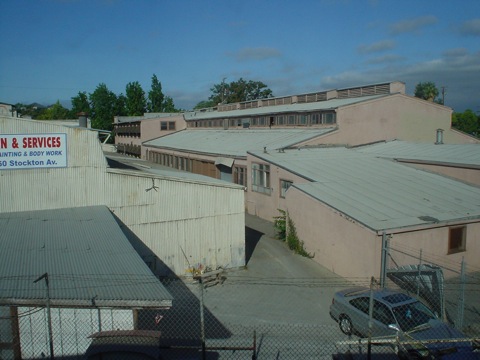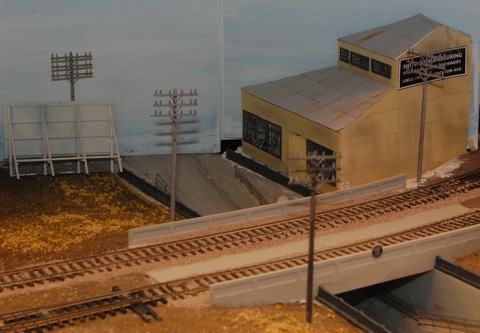
The building always seemed like it would be too recent for my layout, but a glance at a fire insurance map showed that it appeared some time between 1915 and 1950. The map showed the building as the "Smith Manufacturing Company". A bit of searching turned up the following tidbits:
The Smith Manufacturing Company was founded in 1903, and built canning machinery:
"Beginning with a capital of $200, they manufactured machinery for packers, canners and fruit growers, and as the business grew gradually, step by step, they enlarged it from time to time, until in 1916 they purchased their present location, 170 feet front on Stockton Street, at the corner of Alameda, where they have three large buildings, giving 51,000 square feet of floor space. The shops are well arranged. There is a large wood-working department, a machine shop, a metal shop, a foundry, a pattern shop and a boiler-shop, and plans are under way to add some 19,600 square feet of floor space within the year 1922. Each shop and department is equipped with the latest machinery and devices for the manufacture of their different lines of products, 70 per cent of which is shipped outside of and beyond the valley, to domestic and foreign trade. Their goods are shipped to the Orient, South America, South Africa, Australia and the Pacific Islands, as well as to Europe."
[Eugene T. Sawyers' History of Santa Clara County, CA, Historic Record Co., 1922.]
Smith Manufacturing also was known for eventually taking over the manufacturing of Fageol tractors (intended for working well on the soft soil of orchards.)
A rezoning application gives more details on the property:
"The structure located at 138 Stockton Avenue (APN 259-28-004; -005) was built in 1930 for an assembly and fabrication factory, Westem Elevator Manufacturing Company, who manufactured freight and passenger elevators. The structure located at 106-120 Stockton Avenue (APN: 259-28-003) was built between 1916 and 1917 and occupied by the J.S. Smith Manufacturing Company in 1918."
The building I'm modeling probably was the machine shop, 120 Stockton Ave.. I'm not sure why the end was sheathed in steel. Perhaps they were planning to extend the building, or corrugated steel was a cheaper material, or perhaps the relocation of the tracks for Diridon forced them to chop off part of the building.
(Actually, now that I look at my photos, I wonder if I was confusing the corrugated end with the building next door. I can't tell if the pink building had a corrugated end.)

I wanted to build this place because I liked the style. I wanted to model something where the walls were an unbroken line of windows, and wanted to get the clerestory roof and odd angle on the end. I built the rough structure from styrene, used 1/8" square styrene to frame the sides to fit the Scale Structures Ltd. castings for the steel windows. The clerestory windows were also SS Ltd castings found in a dusty, old box at my favorite hobby shop. I made the doors from scribed stock with 1x3 styrene for framing.
The building fits neatly in the tiny lot between the backdrop and the tracks, just at the point where the tracks disappear into staging. The building also sits right next to the Alameda underpass; the few buildings between the Alameda and Smith Manufacturing disappeared so I could fit in this neat model.